WENHAM BINOCULAR MICROSCOPE EXHIBITION MODEL No 664 by A ROSS LONDON, STUNNING
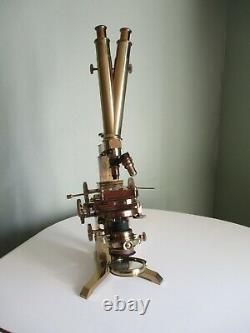
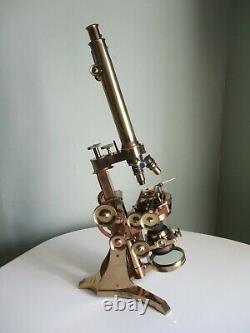

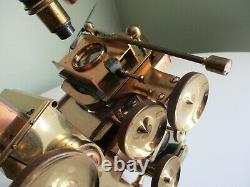
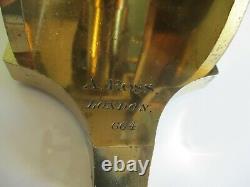
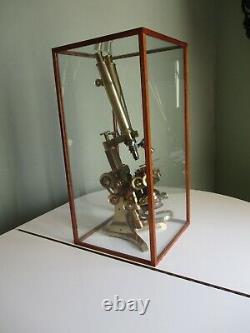
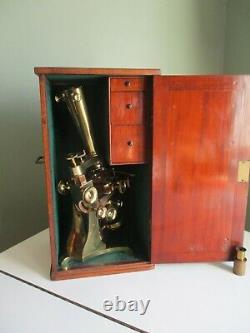
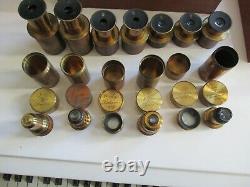
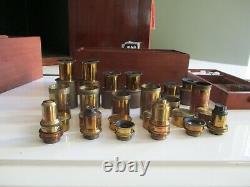


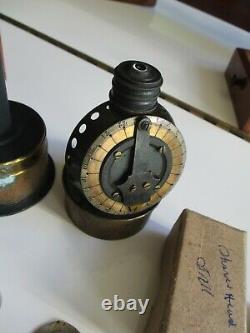

WENHAM BINOCULAR MICROSCOPE "EXHIBITION MODEL No 664" by A ROSS LONDON - MUSEUM QUALITY. This microscope is as good as it gets - IT IS RARE, HUGE, TOTALLY ORIGINAL AND MADE IN LONDON BY ONE OF THE BEST INSTRUMENT MAKERS OF THE TIME; it comes with a WEALTH OF ACCESSORIES, it is in its ORIGINAL FITTED MAHOGANY CASE and even has a KEY WITH A TASSLE. Andrew Ross originally built this fine microscope to commemorate the Great Exhibition in the Crystal Palace in 1851.
This model was so impressive that Ross continued to make it for many years, thereafter. This example has a relatively low serial number so I would suggest that it was probably made in the 1860's. The "Exhibition Model" was the largest and one of the most complex models that Ross ever produced. When the eye-pieces are fully raised this microscope stands 25 inches high! The foot of the microscope is the classic "Ross" Y-shaped slab of brass surmounted by two brass trunnions supporting the main rectangular section limb pivoted near the top to allow the whole instrument to swing through a full 90 degrees. The rotating mechanical stage is adjusted in the x and y directions via racks and pinions operated with knurled thumb wheels. Rotation is by means of a geared ring turned with a thumb screw. There is a parabolic sub-stage condenser with a dark field, all of which may be rotated with a thumb screw via a geared ring. The whole sub-stage assembly can also be adjusted in the x and y directions with yet another pair of thumb screw. At the very bottom is a 3 inch diameter plano-concave mirror with "swing out" facility. The mirror is showing no signs of foxing. The stage is fitted with two pairs of stage forceps. Also on the stage is a brass tray with a large window in it. By adjusting a small thumb screw a very thin wedge section raises and lowers another window below - I do not know the proper name of this assembly but it is engraved with, "Ross London". The binocular tube assembly terminates in a two-way nose-piece at the objective end.The top of these tubes are fitted with rack and pinion adjustment. The right hand tube is engraved with a graduated scale. The main case is of beautiful grained mahogany with a panelled door with lock and key.
It is lined with green baize and fitted with three accessory drawers. On the top of the case is a brass escutcheon let into the wood and as yet no ones initials have been engraved on it! There are two heavy duty concealed brass handles let into either side of the case.There are three pairs marked A, B and C and one other which has a small chip in it's top lens. 1/8 Rofs London (covered) in Ross canister. 1 un named in un named canister. 5" Wray in 5" Wray canister. 1/2" Rofs London (covered) in 1/2" Ross canister.
4" Ross London in 4" Ross canister. 2" W Watson London in 2" W Watson canister. 2/3 Wasson para objective in W Johnson canister. 2mm R & J Beck objective in R & J Beck canister. Stage micrometer 0.1 and 0.01 mm bt Watson and son in fitted case. MALTWOOD'S FINDER photographed by Smith Beck & Beck in fitted case. Sub-stage prism holder with two prisms mounted in cork. Sub stage lens with 23 varying holes, 6 of which have dark fields (I imagine this is the predecessor of the iris diaphragm)?Two brass slides with windows. Top draw fitted as slide tray, (empty).
Many years ago when I acquired this instrument, an earlier owner had a glazed dust cover made, (see picture no 6). My passion is with Physics and Chemistry during the Victorian era, Biology is gooey and smelly! As I swamped with a vast collection the time has come for someone else to love this microscope. If I'm honest I appreciate it more as a feat of engineering than as a biological tool. H: 590 mm / 23.W: 320 mm / 12.5. D: 260 mm / 10.25. Every item is extremely well packaged & only reputable couriers are used. I'm happy to send additional photos via messages. Free collection is very welcome, (IT WEIGHS A TON)!
Whilst you're here, why not take a look at the other items in my shop! The item "WENHAM BINOCULAR MICROSCOPE EXHIBITION MODEL No 664 by A ROSS LONDON, STUNNING" is in sale since Sunday, March 7, 2021.This item is in the category "Antiques\Science/Medicine\Scientific Instruments". The seller is "chemistry63hg" and is located in Newcastle, Staffordshire. This item can be shipped worldwide.
- Period: 1800 to 1900
- Material: Brass & glass
- Type: ELECTROSTATIC INDUCTION COIL Sntific Instruments
- Antique: Yes

